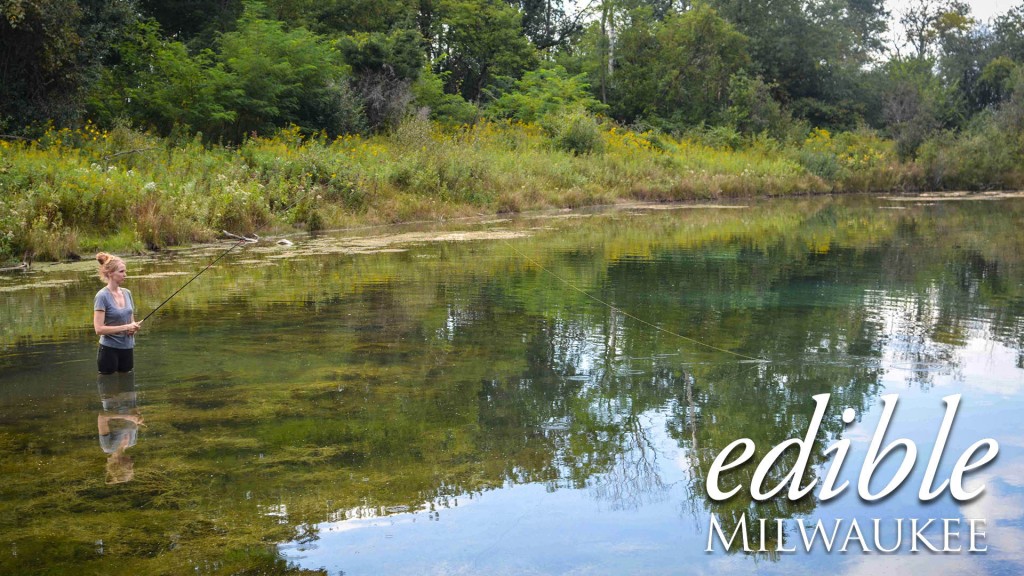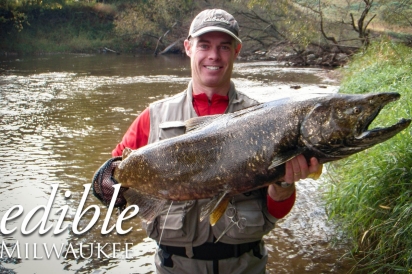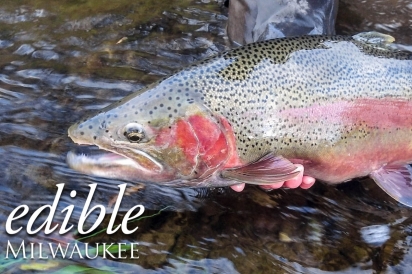Luring the Catch of the Day
Moving to Wisconsin introduced me to the wonders of Bloody Marys with beer chasers, a respect for brats and my very first cheese curd craving. But perhaps the most curious wonder of all was the experience of the Friday night fish fry.
Something about those crispy filets piled over a stack of potato pancakes hushed my hankering for seafood, while days spent wandering through the rolling moraines along the Ice Age trail reminded me that with new geography come new adventures. It also taught me that, in Milwaukee, if you give a girl a fish fry, she will eat well for a day. But teach a girl to fish and she may never leave Wisconsin.
It was on a late spring hike through southern Kettle Moraine that I sent my very first cast with a fly fishing rod, eventually catching what I would later know as the “gateway tug,” according to local fly fisherman Gordon Martin, owner of Tie 1 On in Elkhart Lake. “Catching one is like the gateway drug of fly fishing,” he says. “Once it happens, you’re hooked.” He’s referring to the spirited tug of the bluegill, a type of sunfish that’s abundant in Wisconsin waters and found on many fish fry menus.
But on this particular afternoon, I didn’t know about the great steelhead fighting their way through the urban tributary streams, passing by Miller Park Stadium and through Estabrook Park. I didn’t even know that steelhead was another name for rainbow trout that spend most of their life a good ways out into Lake Michigan before coming through town to spawn in the spring. Or that the DNR stocks the rivers with different strains of steelhead from Kenosha up to Green Bay.
I didn’t know that flies were tiny works of art—a composition of patterned feathers and thread sewn onto tiny hooks, each designed to mimic a different insect the fish might snack on. Or that fly fishing lines are measured from 1 to 12, with 12 being the thick heavy line used to catch the kind of legendary fish likely to grace a mantle, and that there were rods made to accommodate different line sizes. All I knew was that it was a beautiful day to be in the Kettles, in shorts, and in the company of a good friend and naturalist, Ken Keffer.
An educator and wildlife biologist at Wehr Nature Center in Franklin, Keffer keeps a fishing rod (or two) in the trunk of his car for days like this. For us, it started as an adventure to explore new trails and ended with me hip deep in the McKeawn Spring along the side of Highway 67 with a fly rod in my hand, proving that it doesn’t take much gear to experience the wonder of this ancient technique. It does, however, require a fishing license and a trout stamp. But because I was a first-time buyer in Wisconsin, my annual license was only $5; the trout stamp is $10.
I was fortunate enough to be with a veteran fly fisherman in possession of two different styles of rods: a normal fly rod and a tenkara rod. Tenkara is a centuries-old Japanese style of fly fishing in its simplest form, using only a long flexible rod, line and fly (hook)—no reel. The name is suspected to mean “from heaven” or “from the sky,” as the fly would appear from the fish’s perspective, gracefully touching down on the water’s surface. Modern versions are designed like telescopes, extending up to 13 feet and collapsing down to the size of an arrow, making them lightweight and portable companions for backpacking, or in our case, day hiking.
Some fishermen consider tenkara a waning fad after it gained a surge of popularity a handful of years ago when Tenkara USA introduced these Japanese rods to the American market. Other fishermen embrace the option. “It’s hard to tell if it’s just a trend,” says Taylor Todd, one of the fly fishing instructors at Orvis in Glendale. “I have a few buddies that are really into it; I could see it being around for a while,” he says.
Taylor spends his spring weekends at Orvis teaching free fly fishing classes along with fishing manager Erik Helm. “The course is designed to introduce beginners to the sport,” Todd says. “In two hours, we go through knot tying, casting, flies, places to fish, and help everyone find the right equipment.”
Before experimenting with the tenkara rod, I get a lesson in casting from Keffer using a standard fly fishing rod. We wade out into the cool spring, letting our feet sink into the soft bottom. Within striking distance to several cliques of small trout, we start with the basics, an overhead cast. It’s a back and forth motion meant to transfer energy from the rod to the line while keeping the tip of the pole in a straight line. After a few practice casts, I eye up a nearby trout. My line soars above me, back and forth, back and forth, before sailing out to greet my victims. Too short. I try again. Even shorter. After a deep breath, I cast again, watching my fly soar within inches of a curious fish that seems to be lured by the mysterious fly. He’s just about to bite when my eagerness gets the best of me and I pull my line too soon.
Patience is a virtue, and I’ll get plenty of practice today. With each cast, I gain a better understanding of the rod’s movements, the line’s momentum, the timing of pauses between back casts. Right away I understand the therapeutic charm of fly fishing, before even catching a fish. I watch as my instructor moves closer to the bank. With a horizon of shrubbery and branches at his back, he explains the purpose of a roll cast. “You won’t always have room behind you to back cast,” he says, using his wrist to pull the line up into a Dloop before “rolling” the line forward and sending the fly on its way.
Keffer wades back out to where I’m standing. He talks me through another cast, mimicking the motions with his arm. I follow along with the movements, sending my fly out into the water. “We got one!” I yell, my tummy fluttering in the same rhythm of the feisty bluegill on the end of the line.
Call me biased, but it’s been said by many a fishermen that women are better fly fishers. “Women are better listeners, and they have more patience than most men,” explains Martin. “When I take out a group of beginners, the women almost always catch more fish than the men,” he says.
As we reeled in the bluegill, I realized how the excitement of learning on the fly trumped my craving for the Friday night special. With that, I thanked the little sunfish with a kiss on the lips (for good luck) and set it free. But when it comes to falling hard for yet another Wisconsin tradition, I’m not off the hook.
Classes and Guides
Free classes are available at Orvis in Glendale beginning in April. For details and a schedule, visit www.orvis.com/milwaukee or call 414-963-8709. Tie 1 On Guide Service in Elkhart Lake offers fly fishing excursions for beginners and seasoned anglers. For seasonal rates (full or half day trips), visit www.tie1onguideservice.com or call Captain Gordy at 920-876-3510.
License to Fish
The Wisconsin Department of Natural Resources (DNR) offers discounted fishing licenses for first-time buyers or anyone who hasn’t purchased one in the last 10 years. Free licenses are issued to kids 15 and under and active duty military anglers on furlough or leave who are Wisconsin residents. For a complete list of rates, visit www.dnr.wi.gov/topic/fishing/outreach/FishingLicenses.html.
Photos courtesy of Gordon Martin








